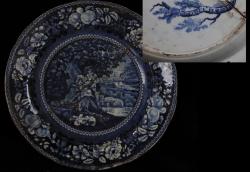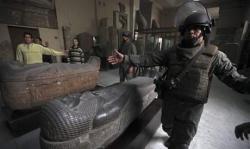INSTITUT SUPERIEUR D'ANTHROPOLOGIE
INSTITUTE OF ANTHROPOLOGY
ONLINE COURSES / COURS A DISTANCE
INSCRIPTION 2012 / Session III : Juillet 2012
REGISTRATION 2012 / Term III : July 2012
USA –  East Troy - When called in on these projects, archaeologists first research records like early plat maps to see if the area reveals anything of potential value. Based on those findings and reviews with project engineers, the crew then does digs, making a series of holes in the ground, sectioning them off and sifting through the dirt — what Reckner calls “more like Discovery Channel archaeology.” Some finds, like an ancient burial mound, can’t be disturbed. In other cases, archaeologists will try to see if artifacts at a site can be saved or at least information recorded before the land is torn up in a construction project. Reckner said he’s surveyed miles-long corridors in some parts of the state and found nothing, while other projects have yielded a wealth of artifacts. In the course of the U.S. Highway 12 survey — which is still going on — Reckner and his crew discovered evidence of three prehistoric campsites and a spear point that dates back 8,500 years — probably shot by some ancient hunter passing through the area. But a surprising yield came from another find.
East Troy - When called in on these projects, archaeologists first research records like early plat maps to see if the area reveals anything of potential value. Based on those findings and reviews with project engineers, the crew then does digs, making a series of holes in the ground, sectioning them off and sifting through the dirt — what Reckner calls “more like Discovery Channel archaeology.” Some finds, like an ancient burial mound, can’t be disturbed. In other cases, archaeologists will try to see if artifacts at a site can be saved or at least information recorded before the land is torn up in a construction project. Reckner said he’s surveyed miles-long corridors in some parts of the state and found nothing, while other projects have yielded a wealth of artifacts. In the course of the U.S. Highway 12 survey — which is still going on — Reckner and his crew discovered evidence of three prehistoric campsites and a spear point that dates back 8,500 years — probably shot by some ancient hunter passing through the area. But a surprising yield came from another find.
http://walworthcountytoday.com/news/2012/may/13/digging-deep-past-near-east-troy/
INDE –  Feroke - The 224-year old Tipu's Fort at Feroke is in a dilapidated state, even two decades after being declared as a protected monument. The fort was constructed in 1788 when Tipu Sultan transferred the capital of his kingdom in Malabar from Kozhikode to Feroke. However, defeated by the British, he handed over the fort to them.
Feroke - The 224-year old Tipu's Fort at Feroke is in a dilapidated state, even two decades after being declared as a protected monument. The fort was constructed in 1788 when Tipu Sultan transferred the capital of his kingdom in Malabar from Kozhikode to Feroke. However, defeated by the British, he handed over the fort to them.
http://timesofindia.indiatimes.com/city/kozhikode/Protected-Tipus-Fort-is-still-in-ruins/articleshow/13101898.cms
ROYAUME UNI -  Brede High Woods - Volunteers are needed for a groundbreaking three week archaeological dig at Brede High Woods. Since December the charity has been undertaking a programme of small-scale excavations and survey work on a medieval farmstead, an iron smelting site and the site of a hop-pickers camp, all found within the woods. The excavations and surveys are attempting to date these and other features as well as determine their use, their construction and how they relate to the Brede Furnace and other historic features in the landscape. To date the excavations have uncovered much domestic ‘rubbish’ associated with Brede High Farm (which was demolished in 1930) and the hop-pickers camp as well as all parts of the iron-smelting process. So far no evidence has been found that positively dates these features but larger scale excavations this year and next will hopefully answer these questions. David Bonsall, site manager for the Woodland Trust said: “We’ve already uncovered some interesting finds which are helping us learn more about the complex history of Brede and we hope that the Big Dig will unearth further forgotten relics.
Brede High Woods - Volunteers are needed for a groundbreaking three week archaeological dig at Brede High Woods. Since December the charity has been undertaking a programme of small-scale excavations and survey work on a medieval farmstead, an iron smelting site and the site of a hop-pickers camp, all found within the woods. The excavations and surveys are attempting to date these and other features as well as determine their use, their construction and how they relate to the Brede Furnace and other historic features in the landscape. To date the excavations have uncovered much domestic ‘rubbish’ associated with Brede High Farm (which was demolished in 1930) and the hop-pickers camp as well as all parts of the iron-smelting process. So far no evidence has been found that positively dates these features but larger scale excavations this year and next will hopefully answer these questions. David Bonsall, site manager for the Woodland Trust said: “We’ve already uncovered some interesting finds which are helping us learn more about the complex history of Brede and we hope that the Big Dig will unearth further forgotten relics.
http://www.ryeandbattleobserver.co.uk/news/local-news/help-uncover-secrets-of-brede-woods-1-3833915
EGYPTE -  Taking advantage of Egypt's political upheaval, thieves have gone on a treasure hunt with a spree of illegal digging, preying on the country's ancient pharaonic heritage.
Taking advantage of Egypt's political upheaval, thieves have gone on a treasure hunt with a spree of illegal digging, preying on the country's ancient pharaonic heritage.
Illegal digs near ancient temples and in isolated desert sites have swelled a staggering 100-fold over the past 16 months since a popular uprising toppled Hosni Mubarak's 29-year regime and security fell apart in many areas as police simply stopped doing their jobs. The pillaging comes on top of a wave of break-ins last year at archaeological storehouses — and even at Cairo's famed Egyptian Museum, the country's biggest repository of pharaonic artifacts.
Horrified archaeologists and antiquities authorities are scrambling to prevent smuggling, keeping a watch on European and American auction houses in case stolen artifacts show up there. "Criminals became so bold they are digging in landmark areas." including near the Great Pyramids in Giza, other nearby pyramids and the grand temples of the southern city of Luxor, said Maj.-Gen. Abdel-Rahim Hassan, commander of the Tourism and Antiquities Police Department. "It is no longer a crime motivated by poverty, it's naked greed and it involves educated people," he said.
In a country with more than 5,000 years of civilization buried under its sands, illegal digs have long been a problem. With only slight exaggeration, Egyptians like to joke you can dig anywhere and turn up something ancient, even if its just pottery shards or a statuette.
But in the security void, the treasure hunting has mushroomed, with 5,697 cases of illegal digs since the start of the anti-Mubarak uprising in early 2011— 100 times more than the previous year, according to figures obtained by The Associated Press from the Interior Ministry, which is in charge of police.
Related crimes have risen as well — 1,467 cases of illicit trading in antiquities and 130 attempts to smuggle antiquities abroad. At least 35 people have been killed in incidents connected to illegal digs, including 10 buried alive in the southern city of Naga Hamadi in March when the hole they dug in the ground caved in. Others were killed in disputes when thieves fell out over sharing the finds, according to Interior Ministry officials familiar with the incidents. They spoke on condition of anonymity because they were not authorized to talk to the press. Those are just the crimes that police uncovered. In their digs, fortune hunters pick spots that are just outside major archaeological sites in hopes that treasures can be found some distance beyond their parameters. Others dig in areas set aside for future excavations by the Supreme Council of Antiquities, Egypt's top state archaeological agency.
Last month, police arrested two men who lived just behind the temple of Khnum in the southern town of Esna for illegally digging under their homes. Police said they found a 10-meter (10-yard) deep hole under the houses with hieroglyphic inscriptions dating to the Ptolemaic dynasty as well as ancient clay pots. Farther south in the Nile-side city of Aswan, police last month arrested a government employee who also dug under his house, uncovering clay pots, an incense urn and tablets bearing images of lotus flowers.
The ministry officials said the surge reflects in part the failure of the police to fully take charge of security after they melted away on Jan. 28 last year, after deadly clashes with protesters on the fourth day of the 18-day anti-Mubarak uprising. Since then, many police have been balking at investigating crimes and pursuing criminals, whether out of resentment over the "revolution" or because of the continued lack of strong political authority.
The night of Jan. 28, thieves broke into the Egyptian Museum, located on the edge of Tahrir Square, the epicenter of the anti-regime uprising and scene of some of the bloodiest clashes between protesters and Mubarak's hated police. The robbers made off with 51 pieces that were on display — of which 29 have since been recovered. The most valuable stolen piece, a statue of the Pharaoh Akhenaten, was found by a 16-year-old protester and his family returned it to the museum, the antiquities ministry said at the time.
Soon after Mubarak's Feb, 11, 2011 ouster, the officials said, a Jordanian man was caught trying to smuggle as many as 3,753 artifacts out of Egypt. These, they said, included 48 ancient Egyptian statutes, Roman Age coins and 45 pieces of jewelry dating from the Medieval years of the Islamic era.
The months that followed saw a rash of break-ins at antiquity storehouses around the country.
"At the end, it's a question of security," said Ahmed Mustafa, who until December headed a government department tasked with recovering stolen artifacts. "The robberies of the warehouses took place in broad daylight by armed thieves. Some were raided twice," said Mustafa, who now lectures on archaeology at a private Cairo college.
One of the largest warehouse thefts took place a year ago in the Sinai city of Qantara, from which roughly 800 artifacts were stolen or damaged by thieves. The pieces, according to regional antiquities chief Mohammed Abdel-Maqsoud, were mostly clay pots, bronze coins and spears dating back to pharaonic and Islamic items.
Nearly 300 of these have been recovered, he said.
Now that security has been beefed up at most warehouses, thieves have turned to digging.
Mansour Bureik, the chief archaeologist in the Luxor area, said there was little chance treasure hunters would run across gold and gems that they dream of — which are found only in royal or aristocratic tombs.
But Galal Mouawad, a senior archaeologist in the Giza area, said the potential for lucky strikes exist just about anywhere in the country.
"Egyptians have over the centuries settled anywhere in Egypt until they have finally settled along the banks of the Nile," he said. "There is something valuable to be found anywhere."
http://www.google.com/hostednews/ap/article/ALeqM5jHsLhxrei2E7YLgSaVF6X_kV4iLA?docId=07dd1190218140ac9eead51b1d92f1ee